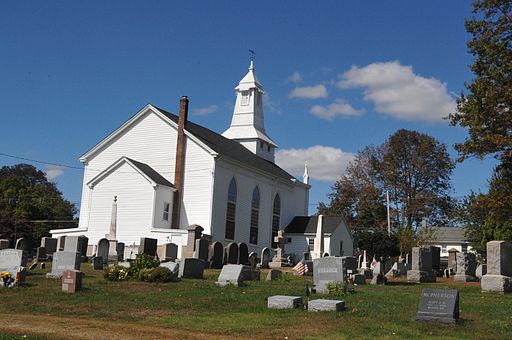According to historian Ursula Brecknell in her book Hillsborough: An Architectural History, it was the 1748 death of Reverend Theodorus Frelinghuysen that "brought to an end a long-simmering theological dispute and a desire to unite in brotherly love". Members of the Dutch Reformed faith in Hillsborough Township who had been variously "alienated and excommunicated" and split among different congregations in Harlingen and Readington now desired to reconcile and form a new congregation closer to home.
 |
| Postcard circa 1905 |
On the 25th of August, 1752, church elders met at Readington to hear the petition for a new congregation with a church to be built somewhere along Amwell Road. Permission was granted to form the Neshanic Dutch Reformed Church, and by October 11 a site was chosen. It wasn't until 1760, however, that a deed to the property - consisting of one acre of land with a dwelling on a knoll on the north side of the road - was obtained.
 |
Postcard circa 1900.
Looking south with a view of the rear of the church and the Sourland Mountain |
Surviving account books show us that work on the church actually began a year earlier, in 1759. Trenches were dug for the foundation, and enormous amounts of stone were cut and hauled from Sourland Mountain. It is likely that services were held in the church before the interior was completed in 1772.
 |
Postcard circa 1908
|
Aside from the massive stone walls, the church looked quite different in those earliest days. It was said to have had a hipped roof with only a weather vane on top - no cupola. The windows were markedly different - not in the Gothic style, and certainly no stained glass. And it is anyone's guess as to what the front facade looked like.
 |
Anna Case returns to the church where she led the choir as an 18-year-old in 1905 and 1906
- one of her first paying jobs - for a church fundraiser, on July 3, 1930. The caption states that she is playing the organ she played years earlier, and that may be so - but a new organ was donated by Andrew Carnegie in 1915 |
A cupola and bell were already in place by 1832 when church members debated how to lengthen the church. Should they add 12 feet to both the north and south ends - or 15 feet to the front (south)? The fact that today it is impossible to tell which they chose, or if another scheme was decided upon, speaks to the fine craftsmanship of the mid-19th century. The lengthening at the front of the church - and we can be pretty sure today we are looking at a 19th-century front facade because of the three entrances - is absolutely seamless in the stonework on each side.
 |
Postcard circa 1905
|
Stained glass windows were likely a late 19th-century addition, as was a remodeling of the interior to a Victorian style. In 1999, with the cupola in desperate need of repair, the church partnered with Bell Atlantic Mobile who provided a replica made of fiberglass in exchange for allowing a cell antenna to be installed within it.
 |
| 1977 National Register photo. |
Today, the Neshanic Reformed Church is the centerpiece of Hillsborough's Neshanic Historic District, entered the National and State Historic Registers in 1979.



























